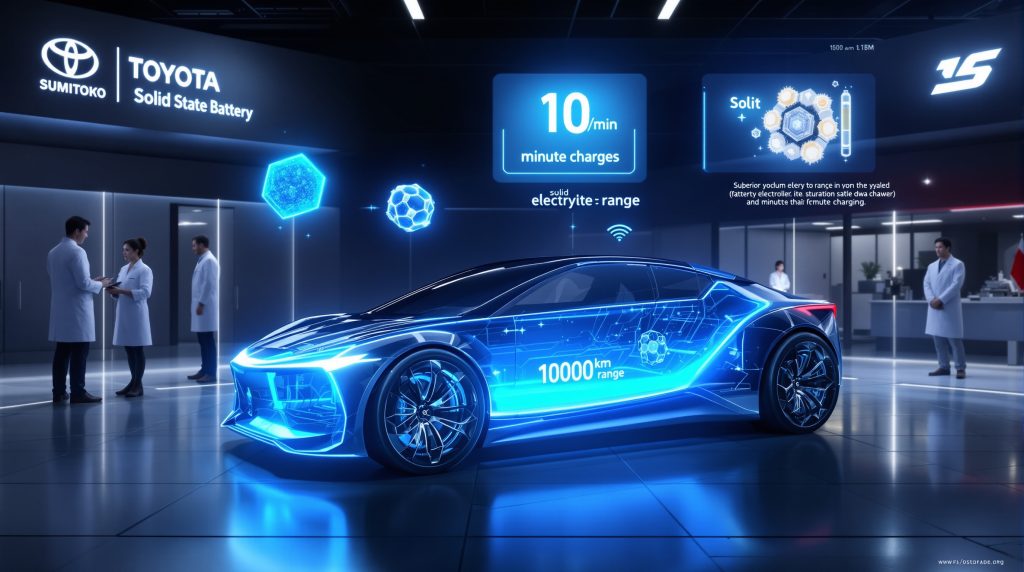Toyota's Solid-State Battery Revolution: Strategic Partnerships and Market Impact
Toyota aims to revolutionize the electric vehicle landscape with cutting-edge solid-state battery technology, positioning itself as a pioneer in a field that could fundamentally transform transportation. Despite its historically cautious approach to full electrification compared to competitors, the Japanese automotive giant is making significant strides in advanced battery development through strategic partnerships and focused research initiatives.
What Are Toyota's Plans for Solid-State Battery Technology?
The Toyota Solid-State Battery Roadmap
Toyota has established an ambitious timeline to launch its first production vehicles equipped with fully-fledged solid-state batteries between 2027 and 2028. This represents a strategic pivot from the company's previously measured approach to electrification, according to information from Toyota's global newsroom published in October 2025.
The automaker has deliberately chosen to bypass incremental battery improvements, instead focusing resources on developing what it considers true next-generation technology. Unlike some competitors who are implementing what Toyota describes as "half-baked semi-solid-state batteries," the company is committed to genuine solid-state electrolyte batteries that completely eliminate liquid components.
This leapfrog strategy could potentially allow Toyota to overcome current limitations in electric vehicles transforming mining while establishing technological leadership in a rapidly evolving market.
Distinguishing True Solid-State from Semi-Solid Technologies
Toyota's approach to solid-state battery technology involves the complete replacement of liquid electrolytes with solid materials across the entire battery architecture. This stands in contrast to semi-solid solutions that retain some liquid components while only partially incorporating solid elements.
The fundamental difference lies in the electrolyte medium through which ions travel between the cathode and anode during charging and discharging cycles. True solid-state batteries, like those Toyota is developing, utilize completely solid materials for this critical component, enabling potentially significant improvements in energy density, safety, and longevity.
Engineering challenges being addressed include interface stability between solid components and the development of manufacturing processes capable of cost-effective mass production. These technical hurdles have previously prevented widespread commercialization of solid-state technology, despite its theoretical advantages being well understood for decades.
How Is the Toyota-Sumitomo Partnership Accelerating Solid-State Battery Development?
Evolution of the Collaborative Relationship
The partnership between Toyota and Sumitomo Metal Mining began in 2021, initially focusing exclusively on research and development activities. According to industry reports from October 2025, this collaboration has recently expanded beyond research to include preparations for mass production.
This evolution marks a significant milestone in the development timeline, indicating that the technology has progressed from theoretical research to practical implementation. The partnership leverages Toyota's expertise in automotive systems integration and Sumitomo's specialized knowledge in materials science and mining.
Sumitomo's approximately two decades of experience in EV battery components provides valuable historical context and technical foundation for the partnership. This long-term perspective on battery material development complements Toyota's vehicle engineering capabilities.
Sumitomo's Breakthrough in Cathode Material Technology
A key advancement in the Toyota-Sumitomo collaboration has been the development of proprietary powder synthesis technology by Sumitomo Metal Mining. This innovation specifically addresses one of the primary obstacles to solid-state battery commercialization: the degradation of cathode materials during repeated charging and discharging cycles.
According to industry publications, Sumitomo has successfully created cathode materials that maintain structural integrity and performance characteristics over numerous charge cycles. This advancement represents a critical step toward creating solid-state batteries with practical lifespans suitable for automotive applications.
The powder synthesis technology leverages Sumitomo's extensive experience in materials science and metallurgy, applying this expertise to solve specific technical challenges in advanced battery chemistry.
Strategic Transition from Research to Manufacturing
The partnership is now entering its commercialization phase after successfully completing critical research milestones. This transition involves gradually scaling production capacity to meet Toyota's 2027-2028 implementation timeline while continuing parallel research efforts to further enhance performance.
The dual-track approach allows for continuous improvement of the technology while establishing the manufacturing infrastructure necessary for high-volume production. This strategy acknowledges both the complexity of new battery technology commercialization and the importance of maintaining research momentum.
Supply chain integration is being established to ensure consistent availability of specialized materials and components. This aspect of the partnership is particularly important given the novel nature of solid-state battery materials and the potential for supply constraints as demand increases.
What Technical Advantages Do Solid-State Batteries Offer for Electric Vehicles?
Performance Enhancements Over Conventional Lithium-Ion
Solid-state battery technology promises significant performance improvements compared to traditional lithium-ion designs. The most notable potential advantages include substantially higher energy density enabling extended driving ranges, potentially approaching or exceeding 1,000 kilometers (621 miles) on a single charge, though these specific figures require further verification from official Toyota sources.
The technology may also enable dramatically faster charging capabilities, with the possibility of full charges in under 10 minutes under optimal conditions. This would address one of the primary consumer concerns regarding electric vehicles: recharging time compared to refueling conventional vehicles.
Power delivery characteristics may also improve with solid-state designs, potentially offering better acceleration and sustained high-performance driving without the thermal limitations that affect current EV batteries.
Safety and Durability Improvements
A fundamental safety advantage of solid-state batteries is the elimination of flammable liquid electrolytes used in conventional lithium-ion cells. This significantly reduces fire risks during accidents, overcharging scenarios, or battery failure events.
The enhanced thermal stability of solid electrolytes minimizes the risk of thermal runaway events that can lead to catastrophic failures in traditional battery packs. Solid-state batteries can typically withstand higher temperatures without degradation or safety concerns.
These batteries may also offer improved structural integrity and resistance to physical damage during collision events, potentially reducing the need for extensive protection systems that add weight and complexity to current EV battery packs.
Battery lifespan may be substantially extended with solid-state technology, potentially reducing the frequency of replacement and improving the long-term economics of electric vehicle ownership.
Form Factor and Integration Advantages
Solid-state battery designs may enable more compact energy storage solutions, allowing for flexible vehicle packaging that could improve both interior space and overall vehicle design. The technology potentially offers a reduced weight-to-energy ratio, enhancing overall vehicle efficiency.
Simpler thermal management requirements could reduce the complexity of cooling systems currently needed for conventional lithium-ion batteries. This would decrease both weight and cost while improving reliability.
There may also be opportunities for structural integration of solid-state batteries into vehicle chassis components, further improving space utilization and potentially enhancing crash protection.
How Will Toyota's Solid-State Battery Technology Impact the EV Market?
Competitive Positioning in the EV Landscape
Toyota's strategic approach to electrification has been notably cautious compared to competitors who have aggressively pursued conventional lithium-ion battery electric vehicles. However, this measured pace may be offset by the company's substantial investment in advanced solid-state technology.
If successful in commercializing true solid-state batteries before competitors, Toyota could potentially leapfrog companies that have invested heavily in conventional lithium-ion technology infrastructure. This would represent a significant strategic advantage in what could be considered second-generation EV technology.
The approach could reposition Toyota from being perceived as an electrification follower to establishing the company as a technology leader, altering competitive dynamics across the industry.
Consumer Benefits and Market Adoption
Solid-state battery technology directly addresses key consumer concerns about electric vehicles. Range anxiety could be substantially reduced with significantly longer driving distances between charges. Charging time improvements could make electric vehicles more practical for a broader range of use cases, including scenarios where rapid refueling is essential.
Improved battery longevity could positively impact residual values and total cost of ownership calculations, making electric vehicles more financially attractive over their lifetime. This could accelerate market adoption rates, particularly in segments where Toyota has traditionally been strong.
The introduction of solid-state technology could also change consumer perceptions about Toyota's commitment to electrification, potentially attracting environmentally-conscious buyers who previously viewed the company as lagging in this area.
Manufacturing and Supply Chain Implications
The transition to solid-state battery production will require entirely new manufacturing processes and equipment, representing both a challenge and an opportunity for automotive supply chains. Toyota and Sumitomo are likely developing vertical integration strategies to secure critical materials and components.
Scaling production capacity presents significant challenges, including specialized equipment requirements, quality control processes, and workforce training. The 2027-2028 timeline suggests a gradual production ramp-up rather than immediate high-volume manufacturing.
There may also be opportunities for technology licensing or expanded partnerships with other automakers, potentially creating new revenue streams and accelerating industry-wide adoption of solid-state technology.
What Are the Key Components of Solid-State Battery Technology?
Critical Materials and Components
Solid-state batteries consist of three primary components: cathode materials (the focus of Toyota's partnership with Sumitomo), anode materials (likely lithium metal or advanced silicon-based alternatives), and solid electrolytes that replace the liquid components in conventional batteries.
The cathode material development has concentrated on creating stable structures that can withstand repeated charging cycles without degradation. This has been a particular focus of the Toyota-Sumitomo collaboration, resulting in proprietary powder synthesis technology.
Solid electrolytes may utilize ceramic or polymer-based materials that offer high ionic conductivity while maintaining physical stability. These materials must facilitate efficient ion transfer between electrodes while providing structural integrity and electrical insulation.
Additional components include current collectors, separators, and enclosure designs specifically engineered for the unique requirements of solid-state architecture.
Manufacturing Process Innovations
Solid-state battery production requires fundamentally different assembly techniques compared to liquid electrolyte cells. New production methods must address temperature and pressure control challenges during manufacturing, as solid components typically require more precise conditions for proper integration.
Quality control protocols for solid-state batteries differ significantly from those used for conventional cells, requiring new testing methodologies and equipment. These must verify not only electrical performance but also the structural integrity of solid interfaces between components.
Automation requirements for consistent high-volume production present unique engineering challenges, as the assembly of solid components typically requires different handling techniques than liquid electrolyte insertion.
Material Science Breakthroughs
A critical area of development involves interface engineering between solid components to ensure efficient ion transfer across boundaries. This represents one of the most challenging aspects of solid-state battery design, requiring precise control of material properties at the microscopic level.
New composite materials are being developed to enhance performance characteristics, combining the benefits of different material types to optimize overall battery function. These often involve nanoscale material optimization to improve ionic conductivity while maintaining structural stability.
Understanding and mitigating degradation mechanisms is essential for creating batteries with practical lifespans. This requires sophisticated modeling and testing to identify failure modes and develop effective countermeasures.
What Challenges Remain for Toyota's Solid-State Battery Implementation?
Technical Hurdles to Overcome
Scaling laboratory success to mass production volumes represents one of the most significant challenges. Techniques that work effectively for small prototype cells often encounter unforeseen difficulties when applied to larger formats and higher volumes.
Maintaining consistent performance across thousands of production units requires stringent quality control and highly refined manufacturing processes. Even minor variations in material properties or assembly techniques can significantly impact battery performance and reliability.
Temperature sensitivity remains a concern for many solid electrolyte materials, particularly in extreme climate conditions. Ensuring consistent performance across the wide temperature ranges experienced in automotive applications presents ongoing engineering challenges.
Compatibility with existing charging infrastructure must be addressed to ensure that vehicles with solid-state batteries can utilize current charging networks while taking advantage of higher power capabilities where available.
Economic and Manufacturing Challenges
Initial production costs for solid-state batteries will likely carry a premium compared to conventional lithium-ion technology due to specialized materials and manufacturing processes. This economic hurdle must be balanced against performance benefits and potential lifetime cost advantages.
Substantial capital investments will be required to establish dedicated production facilities with specialized equipment for solid-state cell manufacturing. These investments represent significant financial risk given the unproven nature of large-scale production.
Developing supply chains for specialized materials presents additional challenges, particularly for components that have not previously been produced at automotive industry scale. Securing reliable sources for these materials is critical for production stability.
The complexity of solid-state manufacturing processes compared to established lithium-ion production methods may impact production efficiency and yield rates, affecting overall economic viability.
Timeline Risks and Competitive Pressures
Meeting the ambitious 2027-2028 production target dates will require successful resolution of numerous technical and manufacturing challenges within a relatively short timeframe. Delays in solving key technical problems could impact the overall implementation schedule.
Competitive pressures from alternative battery technologies continue to intensify as other manufacturers pursue different approaches to improving energy density, charging speed, and safety. These parallel development efforts may result in competing solutions reaching market before Toyota's solid-state technology.
Regulatory certification for new battery technology involves extensive testing and validation processes that can introduce additional delays, particularly for safety-critical components like automotive batteries.
Market acceptance uncertainties remain, as consumer willingness to pay premium prices for advanced battery technology has not been fully tested in mass-market vehicles.
How Does Toyota's Battery Strategy Compare to Industry Competitors?
Contrasting Approaches to Battery Technology
Toyota's strategic focus on solid-state technology represents a different approach compared to competitors who are pursuing incremental improvements to conventional lithium-ion chemistry. While companies like Tesla, Volkswagen, and GM continue to refine existing battery technologies, Toyota appears to be prioritizing a more fundamental technological shift.
This strategy involves longer development timelines with potentially greater rewards, contrasting with the rapid market deployment approach favored by some competitors. Toyota seems willing to accept a temporary competitive disadvantage in the current EV market to potentially secure a significant advantage in future technology.
Vertical integration approaches differ across manufacturers, with some pursuing battery joint ventures or acquisitions while others maintain more distance from battery production. Toyota's close partnership with Sumitomo suggests a more integrated approach to securing critical technology.
The risk profiles of different development pathways vary significantly, with Toyota accepting higher technical risk while companies focused on current-generation technology face potential obsolescence risk if solid-state batteries deliver on their theoretical advantages.
Strategic Partnerships Across the Industry
The Toyota-Sumitomo collaboration can be contrasted with other major automotive-supplier partnerships, such as Volkswagen's investment in QuantumScape and Ford's partnership with Solid Power. Each of these relationships brings different resources and expertise to bear on related technical challenges.
Some manufacturers have adopted relatively open development ecosystems with multiple partners, while others maintain more exclusive relationships. Toyota's approach appears to be more focused on a primary partnership with Sumitomo while maintaining additional research relationships.
Internal development capabilities vary significantly across manufacturers, with some maintaining substantial in-house battery research facilities while others rely more heavily on suppliers and partners. Toyota's hybrid approach combines internal expertise with external collaboration.
Cross-industry partnerships are becoming increasingly common as battery technology development requires expertise from multiple sectors including materials science, electronics, and manufacturing. These diverse knowledge requirements favor collaborative approaches.
Market Positioning and Timing Considerations
The Toyota solid-state battery partnership highlights the tension between first-mover advantages in current EV markets and the potential benefits of waiting for second-generation technology. Toyota appears to be prioritizing technological differentiation over immediate market share in fully electric vehicles.
Regional market strategies vary significantly based on regulatory requirements, consumer preferences, and technological readiness. Toyota's global presence requires balancing these factors across diverse markets with different electrification timelines.
Brand positioning around battery technology has become increasingly important for automakers, with companies emphasizing different aspects of performance, safety, and sustainability. Toyota's focus on solid-state technology aligns with its historical emphasis on reliability and long-term durability.
What Is the Broader Impact of Solid-State Battery Technology?
Environmental and Sustainability Implications
Solid-state battery technology may offer resource efficiency improvements compared to conventional batteries, potentially requiring smaller quantities of certain materials or enabling the use of more abundant alternatives. This could reduce environmental impact and resource constraints.
Lifecycle assessments must consider manufacturing impacts alongside operational benefits, as production of solid-state batteries may initially have different environmental footprints than established technologies. Energy requirements, water usage, and emissions during manufacturing all factor into comprehensive sustainability evaluations.
End-of-life management and recycling opportunities may differ for solid-state batteries, potentially offering improved material recovery compared to conventional designs. The elimination of certain hazardous liquid components could simplify battery recycling breakthrough processes and support high-voltage battery recycling initiatives.
Carbon footprint reductions could extend throughout the supply chain, from raw material extraction to manufacturing and eventual recycling, potentially improving the overall environmental profile of electric vehicles.
Industry Transformation Potential
The commercialization of solid-state battery technology could disrupt established battery manufacturing ecosystems, potentially rendering some current production investments obsolete while creating opportunities for new specialized facilities.
Global supply chain dynamics may shift as different material requirements alter demand patterns for battery minerals and components. Countries with reserves of materials critical for solid-state batteries may gain strategic importance in the automotive supply chain.
New specialized manufacturing capabilities and expertise will be required, creating opportunities for companies that successfully develop these skills while challenging those tied to conventional battery production methods.
Current battery production investments face potential obsolescence risks if solid-state technology delivers significant advantages that accelerate the transition away from conventional lithium-ion designs.
Energy Storage Applications Beyond Automotive
The benefits of solid-state battery technology extend beyond automotive applications to stationary energy storage, where improved safety characteristics and longer lifespans could be particularly valuable for grid stabilization and renewable energy integration.
Consumer electronics applications could benefit from higher energy density and improved safety, potentially enabling slimmer, longer-lasting devices with reduced fire risks. The compact nature of solid-state batteries makes them particularly suitable for space-constrained applications.
Industrial and aerospace sectors may adopt solid-state technology for applications requiring high reliability and safety combined with weight and space constraints. These specialized markets could provide early commercialization opportunities while automotive-scale production develops.
Progress in this field could also contribute to broader energy transition goals by making electricity storage more efficient and accessible, particularly in regions working to establish battery-grade lithium refinery capacity and capitalize on lithium industry innovations.
FAQ: Toyota's Solid-State Battery Development
When will Toyota's solid-state battery vehicles be available to consumers?
Toyota plans to introduce vehicles powered by solid-state batteries between 2027 and 2028, making them among the first automakers to commercially deploy this technology in production vehicles.
How do solid-state batteries differ from current EV batteries?
Solid-state batteries replace the liquid electrolyte found in conventional lithium-ion batteries with a solid material, enabling higher energy density, faster charging, improved safety, and potentially longer lifespan.
What range improvement can consumers expect from Toyota's solid-state battery vehicles?
While specific figures haven't been confirmed by Toyota, industry projections suggest solid-state technology could enable ranges up to 1,000 km (621 miles) on a single charge, representing a significant improvement over current EVs.
Will solid-state batteries make electric vehicles more affordable?
Initially, solid-state batteries may command a price premium, but their improved performance, longevity, and potential for manufacturing optimization could eventually lead to better value and lower total ownership costs.
How does Toyota's approach to electrification compare to other manufacturers?
Toyota has been more cautious in transitioning to fully electric vehicles compared to some competitors, but their substantial investment in advanced solid-state technology suggests a strategy focused on leapfrogging current battery limitations.
Further Exploration
Readers interested in learning more about developments in solid-state battery technology can also explore related educational content available through Toyota's global newsroom and other automotive industry resources that track emerging battery technologies and electric vehicle advancements.
Looking for an Early Edge in ASX Mineral Discoveries?
Don't miss out on the next major resource discovery that could deliver transformative returns. Visit the Discovery Alert discoveries page to understand historic returns from significant mineral finds, and start your 30-day free trial of real-time alerts powered by the proprietary Discovery IQ model.




